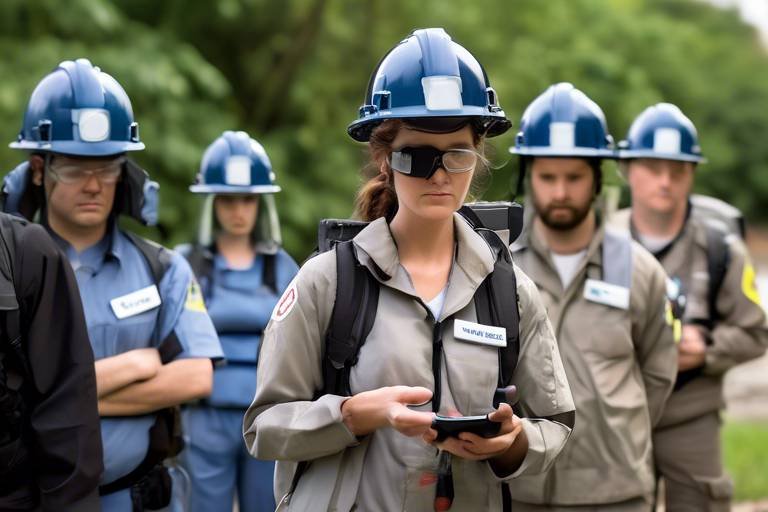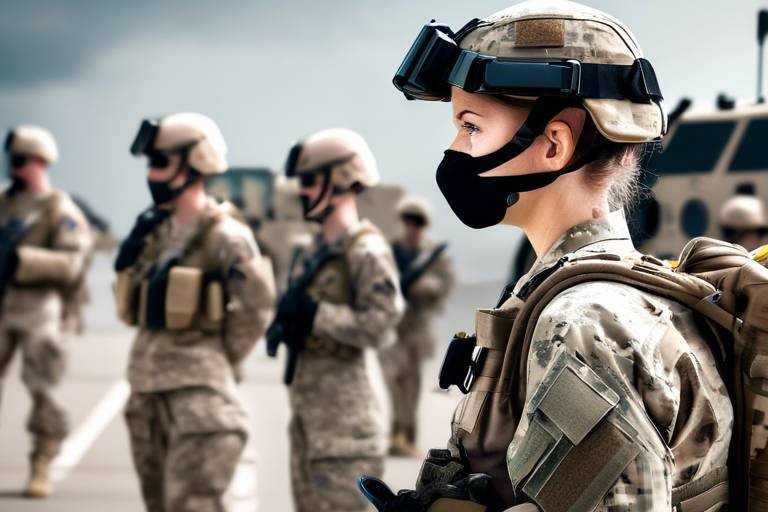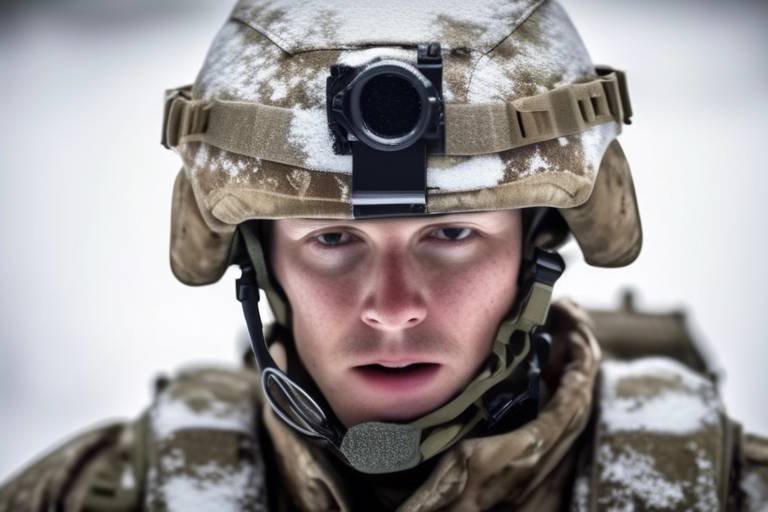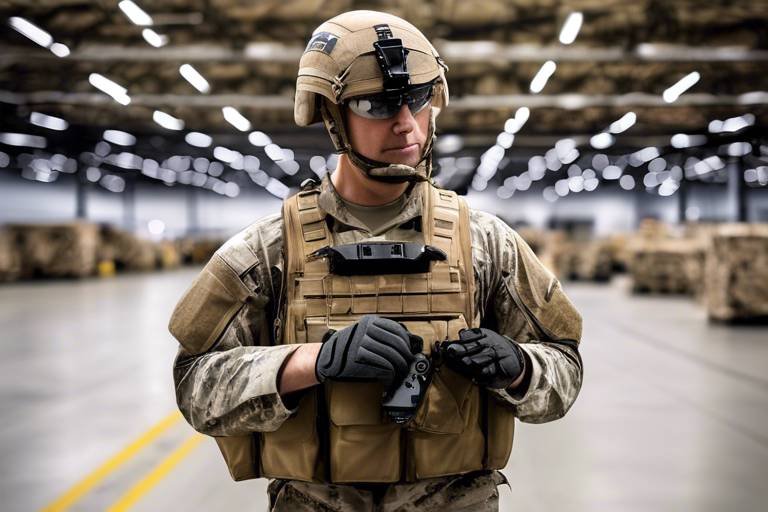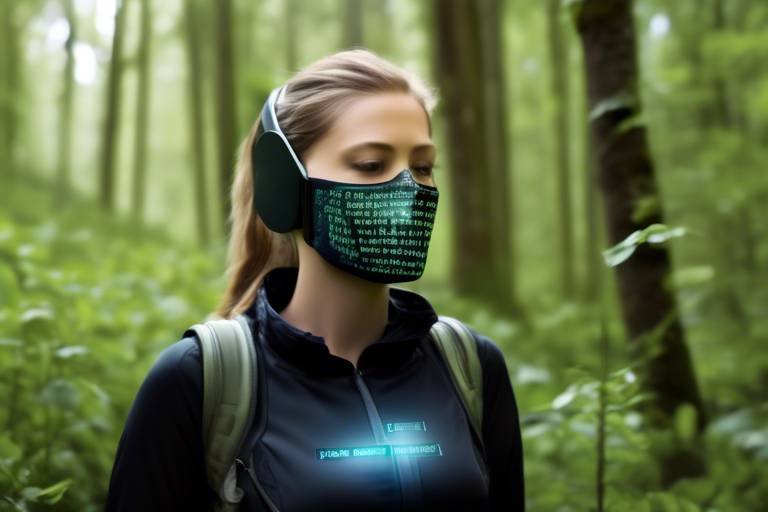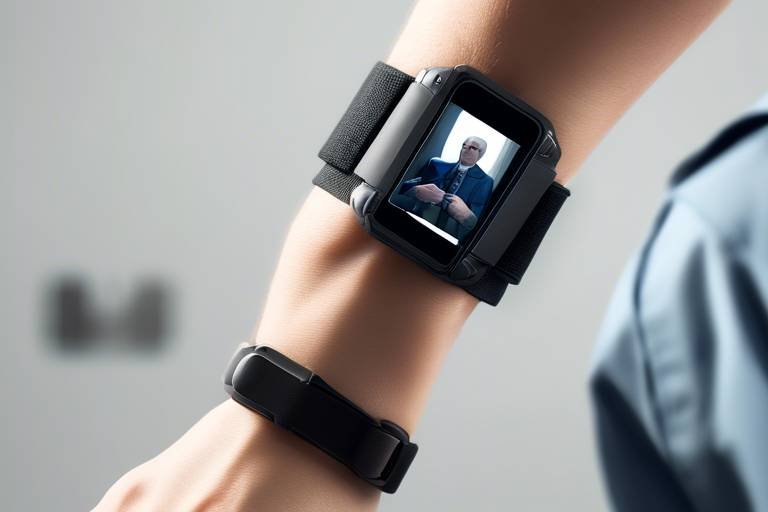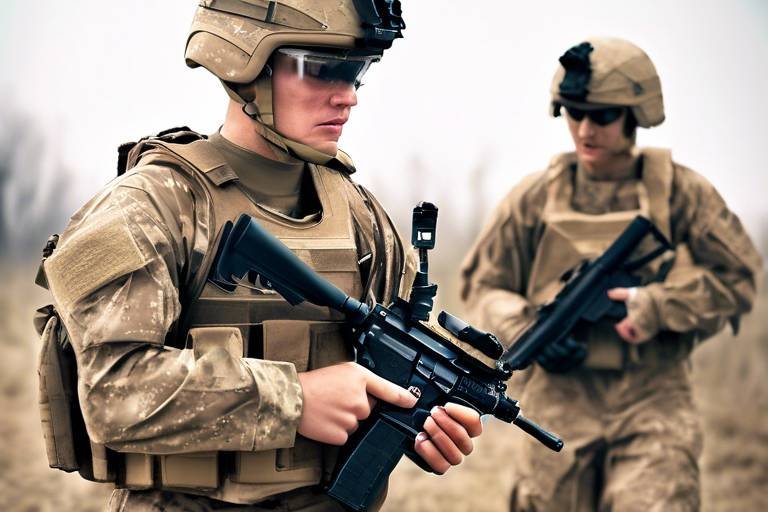The Role of Wearables in Disaster Preparedness Training
In today's fast-paced world, the integration of technology into our daily lives has become the norm rather than the exception. Among the various advancements, wearable technology stands out, particularly in the realm of disaster preparedness training. Imagine a scenario where first responders can monitor their health metrics in real-time while navigating through a simulated disaster zone. This is not just a futuristic dream; it's a reality made possible by wearables. These devices, ranging from smartwatches to advanced fitness trackers, are revolutionizing how we prepare for emergencies.
As we dive deeper into the impact of wearables, it's essential to understand that they do more than just track physical activity. They serve as a lifeline during training exercises, offering crucial data that can enhance both the effectiveness of the training and the safety of the participants. The ability to receive instant feedback, monitor vital signs, and facilitate communication can significantly improve response times and decision-making processes in real-life scenarios. So, how exactly do wearables enhance disaster preparedness training? Let's explore this exciting intersection of technology and safety.
Wearable technology encompasses a broad range of devices designed to be worn on the body, which can monitor health metrics and provide real-time data. These devices are not just for fitness enthusiasts; they have found their way into various sectors, including healthcare, sports, and notably, disaster management. By utilizing wearables, trainers can gather vital information about participants' physical conditions and performance during training sessions. This data is invaluable, especially in high-stress environments where every second counts.
Integrating wearables into disaster preparedness training offers a plethora of advantages that can transform the way participants engage with the material. Here are some of the key benefits:
- Real-Time Feedback: Trainers can provide immediate insights based on the data collected, allowing participants to adjust their actions on the fly.
- Enhanced Communication: Wearables enable seamless communication among team members, which is crucial in chaotic situations.
- Improved Situational Awareness: With access to real-time data, participants can make better-informed decisions during drills.
One of the most significant advantages of using wearables in training is the ability to collect real-time data. This capability allows trainers to monitor participants' performance and health metrics continuously. For instance, during a disaster simulation, trainers can assess how well individuals are performing under pressure and make necessary adjustments to the training program. This data-driven approach not only enhances the training experience but also prepares participants for the unpredictability of real emergencies.
Wearable devices can monitor vital signs such as heart rate, body temperature, and oxygen levels, providing immediate insights into participants' physical conditions. This is particularly important in disaster preparedness training, where physical exertion can be intense. By keeping track of these metrics, trainers can ensure that participants remain safe and can intervene if someone exhibits signs of distress. It's like having a personal health assistant right on your wrist!
Another innovative feature of many wearables is GPS technology, which enables trainers to track participants' locations in real time. This capability is crucial during disaster response simulations, where knowing the whereabouts of team members can enhance safety and coordination. Imagine a scenario where a team is scattered across a simulated disaster site; with location tracking, trainers can quickly assess the situation and provide support where needed.
Effective communication is vital in any emergency situation, and wearables significantly improve this aspect during training. With instant messaging capabilities and alert systems, participants can communicate efficiently, even in high-stress environments. This feature ensures that critical information flows seamlessly, allowing teams to respond quickly to changing situations. Think of it as having a direct line to your teammates, no matter the chaos unfolding around you.
Several organizations have successfully integrated wearables into their disaster preparedness training programs, showcasing improved outcomes and increased engagement. These case studies highlight the transformative power of technology in training environments.
Emergency services have been at the forefront of adopting wearable technology to enhance their training programs. By providing real-time feedback and improving team coordination during drills, these organizations have seen a marked improvement in their preparedness for actual emergencies. For example, a fire department that implemented wearables reported faster response times and better communication among team members during training exercises.
Corporations are also leveraging wearables for employee training in disaster preparedness. By ensuring that staff is equipped with the necessary skills and knowledge to respond effectively in crises, companies can create a safer work environment. This proactive approach not only protects employees but also fosters a culture of safety within the organization.
Q: How do wearables improve safety during training?
A: Wearables monitor vital signs and provide real-time data, allowing trainers to assess participants' health and intervene if necessary.
Q: Can wearables be used in real emergency situations?
A: Yes, wearables can be used in real emergencies to provide vital information and enhance communication among responders.
Q: Are wearables expensive to implement in training?
A: While initial costs may vary, the long-term benefits of improved training outcomes and safety often outweigh the investment.
Understanding Wearable Technology
Wearable technology has become a buzzword in today's tech-driven world, and for good reason! These innovative devices, ranging from smartwatches to fitness trackers, are not just about tracking steps or monitoring heart rates. They are transforming the way we approach various fields, especially in disaster preparedness training. Imagine having a tiny gadget on your wrist that not only keeps tabs on your health but also provides real-time data crucial for survival during emergencies. That's the magic of wearables!
At its core, wearable technology refers to electronic devices that can be worn on the body, seamlessly integrating into our daily lives. These devices are equipped with sensors that collect data, which can be analyzed to provide insights into our physical condition. In the realm of disaster management, this means that trainers can monitor participants' health metrics, including heart rate and stress levels, during training exercises. This real-time feedback can be a game changer when it comes to ensuring the safety and effectiveness of training sessions.
But what makes wearables so essential in disaster preparedness training? Here are a few key aspects:
- Health Monitoring: Wearables can track vital signs such as heart rate, blood pressure, and oxygen levels, allowing trainers to respond quickly if a participant is in distress.
- Location Tracking: Many wearable devices come equipped with GPS technology, enabling trainers to monitor the exact location of participants during simulations.
- Data Analytics: The data collected from wearables can be analyzed post-training to identify areas for improvement, making future training sessions more effective.
In addition to these benefits, wearables also foster a sense of accountability among participants. When individuals know their performance is being monitored, they are more likely to push themselves, leading to enhanced learning outcomes. It's like having a personal coach right on your wrist, encouraging you to do your best!
Moreover, the integration of wearables into training programs is not just about technology; it's about creating a culture of safety and preparedness. By utilizing these devices, organizations can ensure that their teams are not only trained but also equipped with the tools necessary to respond effectively in real-life emergencies. In a world where disasters can strike at any moment, having the right technology can make all the difference.
As we delve deeper into the role of wearables in disaster preparedness training, it's essential to recognize that this technology is continually evolving. With advancements in artificial intelligence and machine learning, we can expect even more sophisticated wearables that will further enhance training outcomes. So, buckle up! The future of disaster preparedness is not just about being ready; it's about being smart and connected.
Benefits of Wearables in Training
Integrating wearable technology into disaster preparedness training is not just a trend; it's a game-changer. Imagine being able to monitor your team's health and performance in real-time while they engage in high-pressure simulations. This capability can significantly enhance training outcomes and ensure that participants are not only learning but also staying safe. With wearables, trainers can access a wealth of data that was previously unavailable, making the training experience more immersive and effective.
One of the most notable benefits of wearables is the provision of real-time feedback. During training exercises, wearables can collect and transmit data on various metrics, such as heart rate, body temperature, and even stress levels. This information allows trainers to make quick adjustments to the training regimen based on each participant's performance and physical condition. For instance, if a participant's heart rate exceeds a certain threshold, trainers can intervene and provide necessary support, ensuring that safety is prioritized throughout the training.
Moreover, wearables enhance communication among participants. In high-stress scenarios, clear communication can be the difference between success and failure. Wearable devices often come equipped with features that allow for instant messaging and alerts, ensuring that all team members are on the same page. This level of connectivity fosters collaboration and can lead to more effective decision-making during disaster response simulations.
Another significant advantage is the enhanced situational awareness that wearables provide. With GPS technology embedded in many wearable devices, trainers can track the location of participants in real-time. This capability is particularly crucial during disaster simulations where understanding the whereabouts of each team member can aid in coordination and safety. For example, if a participant is in a challenging situation, trainers can quickly locate them and provide assistance, thereby reducing the risk of injury or other complications.
In addition to these benefits, wearables can also facilitate data analysis post-training. After a training session, all the data collected can be analyzed to assess performance trends, identify areas for improvement, and refine future training programs. This comprehensive approach ensures that each training session is better than the last, creating a cycle of continuous improvement.
In summary, the integration of wearables into disaster preparedness training offers a multitude of benefits, including:
- Real-time feedback for immediate adjustments
- Enhanced communication for better teamwork
- Improved situational awareness through location tracking
- Data analysis for continuous improvement
These advantages not only enhance the training experience but also prepare participants more effectively for real-world emergencies, making wearables an invaluable tool in disaster preparedness.
Real-Time Data Collection
In the realm of disaster preparedness training, through wearable technology has emerged as a game-changer. Imagine participating in a training exercise where every heartbeat, every breath, and every movement is monitored and analyzed in real-time. This is not science fiction; it’s the reality that wearable devices bring to the table. By collecting vital data on participants' performance and health metrics, trainers can gain invaluable insights into how individuals react under pressure.
Wearable devices, such as smartwatches and fitness trackers, continuously gather data that can be crucial during training exercises. For instance, if a participant's heart rate spikes significantly during a simulated emergency, trainers can intervene promptly, ensuring that safety is prioritized. This immediate feedback loop allows for adjustments to be made on the fly, enhancing the overall effectiveness of the training. The ability to monitor these metrics in real-time means that trainers can tailor their approach to meet the specific needs of each participant, fostering a more personalized training experience.
Furthermore, the data collected is not just useful during the training session; it can also be analyzed post-exercise to identify trends and areas for improvement. For example, trainers can evaluate how different participants responded to stress and pressure, which can inform future training sessions. This data-driven approach ensures that the training is not only reactive but also proactive, preparing participants for real-world emergencies with a level of preparedness that was previously unattainable.
To illustrate the impact of real-time data collection, consider the following table that outlines some of the key metrics monitored by wearables during disaster preparedness training:
| Metric | Importance | Real-Time Application |
|---|---|---|
| Heart Rate | Indicates stress levels and physical exertion | Allows for immediate intervention if a participant is overexerting |
| Oxygen Levels | Critical for assessing respiratory health | Enables trainers to ensure participants are safe during high-intensity scenarios |
| Location Tracking | Enhances safety by monitoring participant movements | Facilitates coordination and response strategies in real-time |
In conclusion, the integration of real-time data collection through wearables into disaster preparedness training not only enhances safety but also revolutionizes the way training is conducted. With immediate insights into participants' physical and emotional states, trainers can provide a more effective learning environment, ultimately leading to better preparedness for actual emergencies. The future of disaster training is here, and it's wearable!
Monitoring Vital Signs
In the realm of disaster preparedness training, through wearable technology has emerged as a game-changer. Imagine being in the midst of a high-pressure training exercise where every second counts. The ability to keep tabs on participants' health metrics, such as heart rate and oxygen levels, can mean the difference between success and failure during real emergencies. With wearables, trainers can gain immediate insights into the physical conditions of their trainees, ensuring that everyone remains safe and capable of performing at their best.
These devices are equipped with advanced sensors that continuously track vital signs, sending real-time data back to trainers. This allows for a dynamic training environment where adjustments can be made on the fly. For instance, if a participant's heart rate spikes beyond a safe threshold, trainers can intervene promptly, providing necessary support or modifying the training intensity to prevent injury or exhaustion. This real-time feedback loop not only enhances safety but also fosters a culture of awareness among participants, as they learn to recognize their own physical limits.
Furthermore, the data collected from these wearables can be invaluable for post-training analysis. By reviewing the vital signs data, trainers can identify patterns and trends that may not be immediately apparent during the training itself. For example, if multiple participants exhibit similar heart rate responses during a specific drill, this could indicate that the exercise is too strenuous or that additional preparation is needed. This kind of data-driven approach allows organizations to continuously improve their training programs, making them more effective and tailored to the needs of the participants.
To illustrate the impact of monitoring vital signs, consider the following table, which summarizes key benefits of using wearables in disaster preparedness training:
| Benefit | Description |
|---|---|
| Immediate Feedback | Trainers receive real-time health data, enabling quick interventions. |
| Enhanced Safety | Monitoring vital signs helps prevent injuries and ensures participant well-being. |
| Data-Driven Insights | Post-training analysis of health metrics informs future training adjustments. |
In conclusion, the ability to monitor vital signs through wearable technology not only enhances the safety of participants during disaster preparedness training but also significantly improves the overall effectiveness of the training programs. As organizations continue to embrace these innovative tools, they pave the way for a more prepared and resilient workforce ready to tackle emergencies head-on.
- What types of vital signs can wearables monitor? Wearables can monitor a variety of vital signs, including heart rate, blood oxygen levels, and even body temperature.
- How do wearables improve safety during training? By providing real-time health data, trainers can quickly identify and address any health issues, ensuring participant safety.
- Can the data from wearables be used for future training improvements? Yes, analyzing the data collected from wearables can help trainers refine and enhance future training programs.
Location Tracking
When it comes to disaster preparedness training, emerges as a game-changer. Imagine a scenario where participants are scattered across a vast training ground, simulating a real-life emergency. In such situations, knowing where everyone is can mean the difference between success and chaos. Wearable devices equipped with GPS technology allow trainers to monitor the precise locations of all participants in real-time. This capability not only enhances safety but also facilitates better coordination among team members.
For instance, during a simulated earthquake response drill, trainers can quickly identify if any participant is in a potentially hazardous area or if someone is lagging behind. With the ability to visualize participants' locations on a map, trainers can make informed decisions about resource deployment and support. This real-time tracking capability fosters a sense of security among participants, knowing that their movements are being monitored, and assistance can be dispatched promptly if needed.
Moreover, location tracking can also provide valuable data for post-training analysis. By reviewing the paths taken by participants during drills, trainers can identify patterns, assess the effectiveness of different strategies, and pinpoint areas for improvement. This feedback loop is crucial for refining training programs and ensuring that participants are well-prepared for actual emergencies.
To further illustrate the benefits of location tracking in disaster preparedness training, consider the following table that outlines key advantages:
| Advantage | Description |
|---|---|
| Enhanced Safety | Real-time monitoring ensures that participants are safe and accounted for during drills. |
| Improved Coordination | Trainers can coordinate responses efficiently based on participants' locations. |
| Data-Driven Insights | Post-training analysis of movement patterns helps refine future training sessions. |
In summary, location tracking not only bolsters the safety of participants during disaster preparedness training but also enhances the overall effectiveness of the training. With real-time data at their fingertips, trainers can create a more dynamic and responsive training environment, ensuring that participants are not just learning but also experiencing the realities of disaster response.
- What types of wearables are commonly used in disaster preparedness training? Devices such as smartwatches, fitness trackers, and specialized GPS-enabled wearables are commonly used.
- How does location tracking improve safety during training? It allows trainers to monitor participants' movements in real-time, ensuring they are safe and can receive help if needed.
- Can location data be used after training sessions? Yes, it provides valuable insights for analyzing performance and improving future training exercises.
Enhancing Communication
In the fast-paced world of disaster preparedness training, effective communication can be the difference between chaos and coordinated response. Wearable devices are revolutionizing how participants communicate during training exercises, making it easier than ever to stay connected. Imagine being in a high-stress situation where every second counts; the ability to send an instant message or alert can be a game changer.
Wearables, such as smartwatches and fitness trackers, come equipped with features that allow for seamless communication among team members. For instance, many devices support instant messaging, enabling participants to share crucial information without having to stop and pull out their phones. This hands-free approach not only saves time but also ensures that communication remains fluid, even in the heat of the moment. Additionally, some wearables offer alert systems that can notify users of important updates or changes in training scenarios, keeping everyone in the loop.
Furthermore, the integration of voice commands in many wearable devices allows participants to communicate verbally without needing to physically interact with their devices. This feature is particularly useful in emergency scenarios where hands may be occupied or where quick responses are necessary. Imagine a firefighter in a training exercise who can call for assistance simply by speaking into their smartwatch. This level of accessibility enhances situational awareness and fosters a sense of teamwork among participants.
To illustrate the impact of enhanced communication through wearables, consider the following table that summarizes key features and their benefits:
| Feature | Benefit |
|---|---|
| Instant Messaging | Quick information sharing without interruptions. |
| Alert Notifications | Real-time updates on training scenarios. |
| Voice Commands | Hands-free communication for immediate responses. |
Moreover, the ability to communicate effectively during training not only prepares participants for real-life emergencies but also builds camaraderie and trust among team members. When everyone is on the same page, the likelihood of a successful operation increases significantly. This sense of unity is crucial, especially when facing unpredictable situations where every member's input and quick thinking can save lives.
In conclusion, enhancing communication through wearable technology is a vital component of disaster preparedness training. It not only streamlines the exchange of information but also fosters a collaborative environment where participants can thrive. As we continue to embrace technological advancements, the integration of wearables into training programs will undoubtedly lead to more effective and efficient disaster response teams.
- What types of wearables are best for disaster preparedness training? Devices like smartwatches, fitness trackers, and specialized communication devices are ideal due to their real-time data capabilities and communication features.
- How do wearables improve safety during training? By monitoring vital signs and providing location tracking, wearables help ensure participants' safety and enable trainers to respond quickly to any issues.
- Can wearables be used in actual disaster scenarios? Yes, wearables can be incredibly useful during real emergencies, aiding in communication and monitoring the health of responders.
Case Studies of Wearable Implementation
In recent years, various organizations have recognized the profound impact of wearable technology on disaster preparedness training. These case studies illuminate how different sectors have successfully integrated wearables into their training programs, resulting in enhanced outcomes and increased participant engagement. For instance, emergency services have been at the forefront of this technological revolution. By adopting wearables, they have transformed traditional training methods into dynamic, real-time learning experiences. This shift not only improves team coordination during drills but also empowers trainees to respond more effectively in genuine emergencies.
One notable example comes from a fire department in California that implemented smart helmets equipped with augmented reality (AR) features. These helmets provide firefighters with real-time data about their environment, including temperature readings and structural integrity assessments. During training exercises, these devices have proven invaluable, allowing trainees to visualize potential hazards and make informed decisions on the fly. The feedback from participants has been overwhelmingly positive, with many noting that the immersive experience significantly enhances their preparedness for actual fire emergencies.
Similarly, corporate entities are increasingly leveraging wearables to train employees for disaster preparedness. A well-known tech company, for instance, introduced a program where employees wear fitness trackers during emergency drills. These trackers monitor vital signs and stress levels, providing trainers with critical insights into how employees react under pressure. The collected data allows trainers to tailor future sessions, ensuring that employees not only learn the necessary skills but also understand how to manage their physical and emotional responses during crises. This approach has led to a marked improvement in employee confidence and readiness, ultimately fostering a safer workplace environment.
To further illustrate the effectiveness of wearables in disaster training, consider the following table that summarizes the key benefits observed in various case studies:
| Organization | Wearable Technology Used | Key Benefits |
|---|---|---|
| California Fire Department | AR Smart Helmets | Real-time environmental data, improved decision-making |
| Tech Corporation | Fitness Trackers | Monitoring stress levels, tailored training sessions |
| Search and Rescue Team | GPS-enabled Wearables | Enhanced location tracking, improved team coordination |
These case studies not only highlight the versatility of wearable technology but also emphasize its critical role in enhancing disaster preparedness training. By providing real-time data, improving communication, and fostering a deeper understanding of individual responses to stress, wearables are changing the landscape of training for emergency scenarios. As more organizations recognize the benefits, it is likely that the integration of these devices will continue to grow, paving the way for a safer and more prepared society.
Q1: What types of wearable technology are commonly used in disaster preparedness training?
A1: Common types of wearable technology include smartwatches, fitness trackers, AR helmets, and GPS-enabled devices. Each serves a unique purpose, from monitoring health metrics to providing real-time environmental data.
Q2: How do wearables improve communication during training exercises?
A2: Wearables enhance communication by allowing participants to send instant messages, alerts, and updates to one another. This feature is particularly useful in high-stress situations where quick coordination is essential.
Q3: Are there any challenges associated with implementing wearables in training?
A3: Yes, challenges can include the initial cost of devices, ensuring all participants are comfortable using the technology, and addressing privacy concerns related to data collection.
Q4: Can wearables be used outside of disaster preparedness training?
A4: Absolutely! Wearable technology has applications in various fields, including healthcare, fitness, and even corporate training, making it a versatile tool for enhancing performance and safety.
Emergency Services Training
In the realm of emergency services, training is not just a routine; it's a lifeline. The integration of wearable technology has revolutionized how these services prepare for real-life scenarios. Imagine a firefighter in the midst of a training exercise, equipped with a smartwatch that monitors their heart rate and oxygen levels. This isn't science fiction; it's the reality of modern training programs. By providing real-time data, wearables allow trainers to assess the physical condition of their team members instantly, ensuring that everyone is fit to respond when the alarm bells ring.
One of the standout features of wearables in emergency services training is their ability to enhance team coordination. During drills, communication can often break down under pressure. However, with wearable devices, instant messaging and alerts can flow seamlessly between team members. Picture a chaotic scene where every second counts; a simple alert sent through a wearable can direct a firefighter to switch tactics or assist a colleague in distress. This kind of communication is crucial, especially in high-stress environments where clarity can mean the difference between success and failure.
Moreover, the use of wearables in training exercises extends beyond just monitoring health metrics. They can also track participants' locations in real-time. This feature is particularly beneficial during large-scale disaster simulations where multiple teams are deployed across a vast area. Trainers can easily see where each participant is located, allowing for better management of resources and personnel. For instance, if one team encounters an unexpected challenge, trainers can quickly reallocate support based on real-time data, ensuring that no one is left isolated or unsupported.
To illustrate the effectiveness of wearables in emergency services training, let's look at a few key benefits:
- Improved Safety: Continuous monitoring of vital signs helps prevent overexertion and ensures that all team members are fit for duty.
- Enhanced Decision-Making: Real-time data allows trainers to make informed decisions quickly, adapting training scenarios as needed.
- Increased Engagement: The interactive nature of wearables keeps participants engaged, making training more dynamic and effective.
In conclusion, the adoption of wearable technology in emergency services training is not just a trend; it's a necessary evolution in how we prepare for disasters. As these devices continue to advance, we can expect even greater enhancements in training methodologies, ultimately leading to more effective emergency responses. The future of disaster preparedness is bright, and wearables are at the forefront of this transformative journey.
Q: How do wearables improve safety during emergency training?
A: Wearables monitor vital signs and provide real-time feedback, allowing trainers to ensure participants are physically capable of handling the demands of the training.
Q: Can wearables be used in large-scale disaster simulations?
A: Yes, wearables equipped with GPS tracking enable trainers to monitor the locations of all participants, facilitating better coordination and resource management.
Q: What types of wearables are commonly used in emergency services training?
A: Common devices include smartwatches, fitness trackers, and specialized communication devices designed for high-stress environments.
Q: How do wearables enhance communication among team members?
A: Wearables allow for instant messaging and alerts, ensuring that team members can communicate effectively even in chaotic situations.
Corporate Disaster Preparedness
In today's unpredictable world, where natural disasters and emergencies can strike at any moment, has taken on a new level of importance. Companies are increasingly recognizing that their employees are their most valuable asset, and protecting them during crises is paramount. One of the most effective ways to ensure that staff are well-prepared is through the integration of wearable technology into training programs. These devices not only enhance the learning experience but also provide essential tools for real-time monitoring and communication.
Imagine a scenario where a sudden earthquake occurs during a corporate training exercise. Employees equipped with wearables can immediately receive alerts and instructions, allowing them to respond swiftly and effectively. By leveraging technology, organizations can create a dynamic training environment that simulates real-life emergencies, preparing staff to act decisively when it matters most.
Moreover, wearables can track employees' health metrics, such as heart rate and stress levels, during training exercises. This data is crucial for trainers to assess how individuals react under pressure. For instance, if a participant's heart rate spikes significantly, trainers can intervene and provide necessary support, ensuring that everyone is physically and mentally prepared for real-world situations. This level of personalized feedback not only enhances safety but also boosts confidence among employees.
To illustrate the impact of wearables on corporate disaster preparedness, consider the following table showcasing key benefits:
| Benefit | Description |
|---|---|
| Real-Time Monitoring | Wearables provide immediate insights into employees' physical conditions, allowing for timely interventions. |
| Enhanced Communication | Instant messaging and alerts facilitate seamless communication during emergencies. |
| Improved Coordination | GPS tracking enables effective location management, ensuring safety during drills. |
Furthermore, companies that implement wearables in their disaster preparedness training often see a significant increase in employee engagement. The interactive nature of these devices makes learning more enjoyable, transforming what used to be a mundane safety drill into an exciting and immersive experience. Employees are more likely to retain information and feel confident in their abilities to handle emergencies when they are actively participating in their training.
In addition to enhancing training outcomes, wearables can also play a crucial role in post-training evaluations. Organizations can analyze the data collected during training sessions to identify areas for improvement, ensuring that future training is even more effective. This continuous feedback loop not only strengthens the preparedness of the workforce but also fosters a culture of safety and resilience within the organization.
In summary, the integration of wearable technology into corporate disaster preparedness training is a game-changer. By providing real-time data, enhancing communication, and improving overall engagement, wearables equip employees with the skills and confidence they need to respond effectively in emergencies. As companies continue to invest in their workforce's safety, the use of wearables will undoubtedly become a standard practice in disaster preparedness training.
- What types of wearables are commonly used in corporate disaster preparedness?
Common wearables include smartwatches, fitness trackers, and specialized devices designed for health monitoring and communication during emergencies.
- How do wearables improve communication during emergencies?
Wearables facilitate instant messaging and alerts, allowing for quick dissemination of information and coordinated responses among team members.
- Can wearables help track employee health during training?
Yes, wearables can monitor vital signs such as heart rate and stress levels, providing trainers with valuable insights into participants' physical conditions.
- What are the long-term benefits of using wearables in training?
Long-term benefits include improved employee preparedness, increased engagement in training programs, and enhanced overall safety within the organization.
Frequently Asked Questions
- What are wearable technologies?
Wearable technologies refer to devices such as smartwatches, fitness trackers, and other gadgets that can be worn on the body. These devices monitor various health metrics and provide real-time data, making them essential tools in sectors like disaster management and preparedness training.
- How do wearables enhance disaster preparedness training?
Wearables enhance disaster preparedness training by offering real-time feedback, improving communication among participants, and increasing situational awareness. This leads to more effective training outcomes, as trainees can receive immediate insights into their performance and health metrics during exercises.
- Can wearables monitor vital signs during training?
Absolutely! Wearable devices can monitor vital signs such as heart rate and oxygen levels. This capability provides trainers with crucial insights into participants' physical conditions, ensuring safety and effectiveness throughout the training process.
- Is location tracking possible with wearable devices?
Yes, many wearables come equipped with GPS technology, allowing trainers to track participants' locations in real-time. This feature enhances safety and coordination during disaster response simulations, ensuring that everyone is accounted for.
- How do wearables improve communication among training participants?
Wearable devices facilitate instant messaging and alerts, which can be critical in high-stress disaster scenarios. This improved communication helps teams respond more effectively and stay connected during training exercises.
- Are there real-world examples of wearables being used in disaster preparedness training?
Yes! Several organizations, including emergency services and corporations, have successfully integrated wearables into their disaster preparedness training programs. These implementations have demonstrated improved training outcomes and increased participant engagement through innovative technology.
- What benefits do corporations gain from using wearables for employee training?
Corporations benefit from using wearables by ensuring their staff is equipped with essential skills and knowledge to respond effectively in crises. This proactive approach to training can significantly enhance employee safety and preparedness during actual emergencies.

